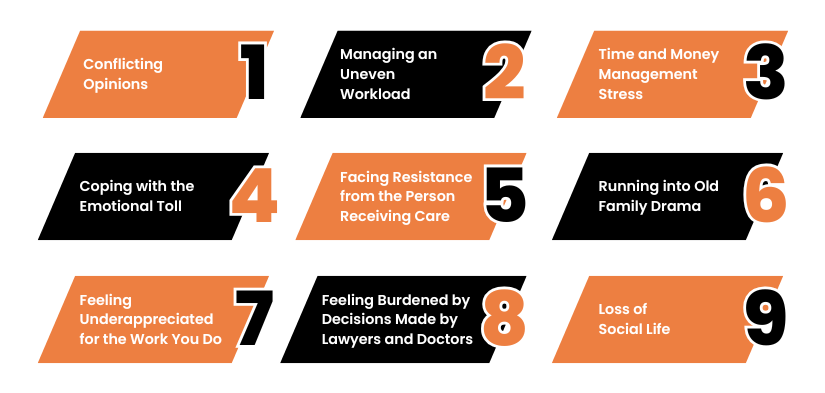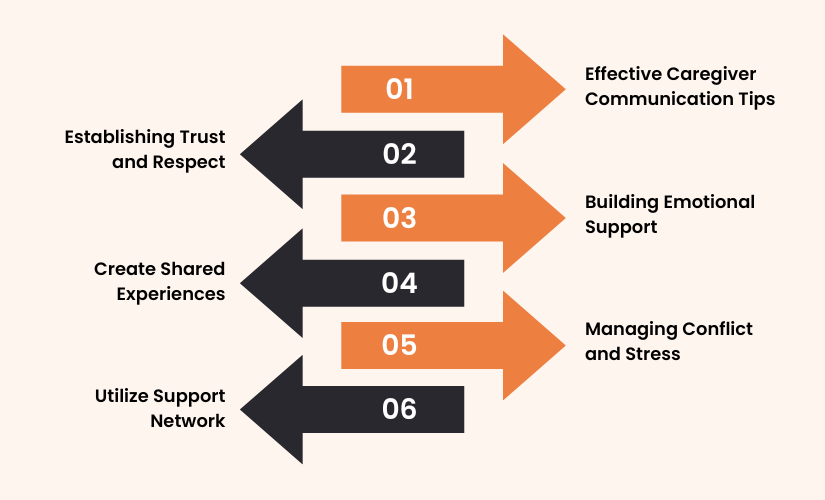Strengthening Bonds: How Caregivers and Families Can Connect Better

Relationships between caregivers and families play an important role in caring for seniors at home. It’s like the glue that holds everything together. It’s all about relationships, from the person taking care of the senior to the doctors and nurses involved, and even the connection between the community and the places where they get healthcare.
Annie Dillard, a famous writer, once said, “How we spend our days is, of course, how you spend our lives.” This means that how you spend your time daily is how you live your life in the long run. This is true when it comes to the bond between caregivers and families. For many older folks, the caregiver is the person they spend the most time with, so families must have a good relationship with them.
In this article, we’ll dive into how you can strengthen these bonds between caregivers and families. We’ll talk about the problems you might face, the good stuff that happens when you connect well, and some ideas for making those connections even better.
Understanding the Caregiver-Family Relationship
“Effective communication with family members starts with accepting that reality without resentment.”
– Barry Jacobs
The caregiver-family relationship is crucial in caregiving. Caregivers typically work very closely with family members with their views, feelings, and hopes about how to give care. It is the first step towards creating a friendly and helpful environment. Sometimes, they’re all singing the same song. Other times? Not exactly.
Sorting Out Who Does What
One of the most crucial challenges in caregiving is who does what. For example, some members of the family take the responsibility to manage real hands-on tasks, including feeding, bathing, or medications, while others handle the money or act as emotional guardians.
The problem? These roles do not always get discussed, and assumptions start flying. One sibling might think checking in once a week is “helping enough,” while another is completely overwhelmed doing everything. Without clear communication, caregiving turns into a pressure cooker of stress.
Challenges That Can Strain Caregiving Relationships
Even in the closest families, caregiving can bring tension. Some of the biggest challenges include:

- Conflicting Opinions: Ask three family members the best way to handle care, and you will get three totally different answers. One may prefer professional help, another keeping things in the family, while the third person believes that a nursing home is the best. Decisions concerning health, daily habits, or financial issues can lead to arguments.
- Managing an Uneven Workload: In nearly every family, someone does most of the caregiving. It’s either because of distance and work schedules or just because one individual in a family tends to avoid it; this natural imbalance causes resentment. The primary caregiver is exhausted and unsupported while others hardly realize how much they’re asking of them.
- Time and Money Management Stress: Caregiving is emotionally draining but also time-consuming and expensive. Most caregivers are also juggling a full-time job, children, and personal responsibilities while keeping up with the needs of their loved one. Added to this, medical bills, home modifications, and supplies all add up very quickly, straining the family further.
- Coping with the Emotional Toll: Watching a loved one decline in health is hard. Caregivers often feel a mix of guilt, frustration, sadness, and exhaustion. Sometimes, you’re grieving the person they used to be, even though they’re still here. The emotional weight of caregiving can make even small family disagreements feel overwhelming.
- Facing Resistance from the Person Receiving Care: Not everyone likes being cared for. Some older adults refuse help with basic tasks, ignore medical advice, or push back against necessary changes. This resistance can be frustrating, especially when you’re trying to do what’s best for them.
- Running into Old Family Drama: If sibling rivalries or family tensions weren’t resolved before caregiving started, they are certainly going to surface now. Conflicts about caregiving quickly turn into battles over “who Mom loved best” or “who never pulled their weight.” Caregiving has a way of bringing up old wounds no one thought they’d have to deal with again.
- Feeling Underappreciated for the Work You Do: Caregiving can feel like a thankless task. Many family members who are not involved do not glimpse the physical, mental, or emotional toll of caregiving. When caregivers feel that no one appreciates or supports them, they start to burn out and resent their situation.
- Feeling Burdened by Decisions Made by Lawyers and Doctors: Power of attorney, advance directives, insurance, medical choices—caregiving isn’t just about daily tasks. There are a lot of legal and medical details to sort through, and navigating all of it can be completely overwhelming, especially when family members don’t agree on what should be done.
- Loss of Social Life: The needs of the caregivers become a backburner issue. Between the doctors’ appointments, daily routines, and family responsibilities, little time is left to pursue hobbies, friends, or even a quiet moment alone. Over time, this isolation takes a serious toll on mental health.
Top Ways of Improving Relationships Between Families and Caregivers

Strategy #1: Effective Caregiver Communication Tips
Effective communication is at the heart of strong caregiver-family relationships. Here are a few significant tips for the caregiver to improve understanding and teamwork:
- Practice Active Listening: Active listening is not by the words but by understanding what a person wants to feel behind the words. Caregivers should listen to what the family members say and reflect on those involved’ feelings and worries. This would make them listen and be valued, building cooperation and trust.
- Be Open and Honest: Honesty is very important in any relationship, especially caregiving. For example, an issue with a senior’s health or having trouble providing care should be open discussion. Family members have to be able to mention their worries without being judged. TOpennesswill help everyone understand what is happening and work together to provide support.
- Boundary Setting: Boundaries of relationships have to be kept healthy. Carers must communicate how much time, energy, and emotions they can allocate. On the other hand, members must tell what they want and expect. All these clear boundaries help them to respect other people’s space and time and their jobs, bringing down conflict and misunderstanding.
- Get Families Involved: Encouraging family members to participate in caregiving can strengthen the caregiver-family relationship. For instance, families can help with day-to-day tasks, such as taking a member to the doctor for check-ups or providing company. Involvement brings most people together and facilitates the distribution of responsibilities, thus helping the primary caregivers.
- Technology for Keeping in Touch: Technology can be employed in communication between family members in this modern digital world. For example, there are messaging apps, video calls, and shared calendars that keep everyone updated about the status of the older adult and their caregiving activities. Regular technology-based communication ensures that even distant family members stay involved and informed.
Strategy #2: Establishing Trust and Respect
- Recognize Emotions: Everyone who is for someone feels many different emotions, such as love and care, frustration and sadness. These feelings must be realized and admitted to. For instance, the family member may be annoyed with what he is obliged to do. This knowledge of emotions helps create an atmosphere where people feel appreciated and respected.
- Provide a Safe Space to Talk: Encourage family members to share what they think and feel without fearing judgment. Creating a safe place for talking will help have open and honest talks about challenges in caregiving relationships. Schedule family meetings regularly to discuss care plans, worries, and success stories. Doing this makes the caregiver-family relationship stronger and builds teamwork.
- Give Thanks: Gratitude can influence relationships. Consistent and periodic acknowledgment of family for their time and effort spent by them makes them feel valued in the relationship. A simple “thank you,” or a little note to express gratitude can work wonders in building trust and respect among the family members.
Strategy #3: Building Emotional Support
The responsibility of caregivers towards the care of seniors is very painful to their feelings. One needs to extend emotional support to each other. Here are some ways to encourage such support:
- Observe Signs of Stress: Caregivers and family members can also experience stress, anxiety, or burnout. Watch for warning signs: irritability, fatigue, or wanting to be left alone. When you or they are displaying these symptoms, act. Volunteer to give them a break or suggest doing something together to help manage the stress, like taking a walk or pursuing an activity they enjoy.
- Focus on Self-Care: Caring for oneself is an important part of the process for caregivers and family members. Help each other make personal health a priority. This can be making time for hobbies, exercise, or relaxation. When caregivers take care of themselves, they can better care for seniors, benefiting everyone.
- Call in Professional Help if Needed: If they are emotionally overwhelmed, professional help can be sought. Therapists and counselors can provide much support and coping strategies. Let family members seek this if they find themselves emotionally challenged with caregiving.
Strategy #4: Create Shared Experiences
Every memory shared strengthens the bond between caregivers and their families. Here are some ideas for creating important moments together:
- Engage in Activities with the Elderly: Such activities can help create lasting memories and closer bonds between family members. Activities like cooking, gardening, or even playing games can be made more fun for everyone involved. These can ease the tenseness of everyone who does such activities.
- Mark Important Occasions Together: Celebrate birthdays, anniversaries, or achievements to bring the family closer. Planning for small get-togethers on such occasions helps create a feeling of togetherness and love. Even at a small level, success can turn the care relationship positive.
- Record Memories: A special journal or scrapbook can be kept to remember important events in the senior’s life. This can be encouraged for family members to share their thoughts, pictures, and stories to come together closer and create a lasting memory.
Strategy #5: Managing Conflict and Stress
Some conflicts may arise in any relationship, especially when caring for someone. Here are some ways to handle conflict and stress:
- Solve Problems Quickly: If conflicts arise, solve them quickly instead of letting them grow. Waiting to talk about disagreements may cause bad feelings. Discuss the issue calmly and respectfully, trying to find solutions instead of blaming each other.
- Use “I” Statements: Talk about feelings or frustrations using “I” statements instead of “you” statements. Thus, for instance, state, “I get overwhelmed when there are just too many decisions,” and not, “You never listen to me.” It can illustrate feelings without blaming the person and help the family members be more understanding.
- Utilize Conflict Resolution Techniques: Create ways of resolving conflicts as a family. For example, take breaks during intense talks to relax before talking again. Encourage finding a middle ground and working together to discover solutions that benefit everyone involved.
Strategy #6: Utilize Support Network
Support networks can be extremely supportive for caregivers and families. Here’s how to use them well:
- Identifying Community Resources: Find local resources for caregiving and families, including break services, support groups, or classes, that can help provide care and important information about caring for seniors.
- Join Support Groups: Support groups can also be helpful, where caregivers share experiences, challenges, and solutions. It helps connect with others who understand the caregiving journey, bringing emotional relief and a sense of belonging. Such groups usually offer helpful insights on managing caregiving relationships and finding resources.
- Share Resources with Family Members: Inform family members about the resources available. Share articles, websites, and local services that could benefit them. This ensures everyone is informed and can collaborate to get that support.
Wrapping Up
Building strong connections between caregivers and families can be challenging, but it’s worth it. By talking openly, planning, staying updated, respecting each other, and learning together, you can create a supportive environment where seniors feel safe, loved, and cared for. So keep working on those relationships and making them even stronger!


